Ospedale degli Innocenti (Spedale degli Innocenti)

Ciao a tutti!!
FINALLY!! Here's the post I mean to put up a few days ago! I swear, I have no idea where the time gets to! One minute I'm waking up, still amazed at the fact that I'm waking up in Italy, and the next, I'm passing out with exhaustion on my bed at night!
Anyway, so this past Monday, I went with two girls in my apartment, Marissa and Kelsey to the Foundling Museum. It was truly an amazing experience and so interesting to learn about.
For her class, Marissa had to give a presentation on the Ospedale degli Innocenti, so Kelsey and I, interested in the subject and learning about the Ospedale, decided to tag along to see what the foundling museum was all about. Here are some notes that Marissa took for her class that I thought would be a great overview of what the museum is all about! We spent a good few hours there and I would certainly suggest reading the notes below, certainly worth taking some time to read about! Also, if you ever happen to make it to Florence, I would absolutely recommend visiting the Ospedale, which is located about 3 minutes from the Duomo!
The Building:
· Building was designed by Brunelleschi – directed the construction between 1419-1424
· Financed by the Arte della Lana – wool guild of Florence
o Design was based on an Italian Romanesque architecture – many arches and windows with iron bars so that no one could get in
o The arcaded portico was the first classical loggia (terrace) in the city and it served as an example for other Renaissance architects.
o The façade is decorated with ceramic glazed medallions illustrating swaddled babies which were created by Andrea della Robbia (http://www.aviewoncities.com/florence/piazzadellasantissimaannunziata.htm)
§ Andrea della Robbia was a Florentine artist who specialized in ceramic reliefs
· Brunelleschi’s plan included a square court yard outlined in arcades behind the façade portico, flanked by two large areas of equal dimensions: the church and the living quarters for the children
CHECK OUT SOME PHOTOS FROM the Oespedale! ENJOY!!
FINALLY!! Here's the post I mean to put up a few days ago! I swear, I have no idea where the time gets to! One minute I'm waking up, still amazed at the fact that I'm waking up in Italy, and the next, I'm passing out with exhaustion on my bed at night!
Anyway, so this past Monday, I went with two girls in my apartment, Marissa and Kelsey to the Foundling Museum. It was truly an amazing experience and so interesting to learn about.
For her class, Marissa had to give a presentation on the Ospedale degli Innocenti, so Kelsey and I, interested in the subject and learning about the Ospedale, decided to tag along to see what the foundling museum was all about. Here are some notes that Marissa took for her class that I thought would be a great overview of what the museum is all about! We spent a good few hours there and I would certainly suggest reading the notes below, certainly worth taking some time to read about! Also, if you ever happen to make it to Florence, I would absolutely recommend visiting the Ospedale, which is located about 3 minutes from the Duomo!
The Building:
- Established in 1419
- Built as a home for foundlings
- Located on eastern side of Piazza della Santissima Annunziata
- The other two buildings parallel and next to the hospital were built later to imitate Brunelleschi’s building
- Was named after the Innocents of Herod’s massacre – Old Testament reference
- Orphanage opened in 1445
- The Ospedale degli Innocenti originally followed Tuscan tradition in admitting its foundlings by means of an ancient stone column which was set outside the loggia (terrace) in the front of the building
- Mothers would ring the bell and the stone was rotated 180 degrees, taking the baby inside the orphanage
- This was replaced in the late 15th century by the “grated window” also known as the crib, hole and wheel
- Orphanage allowed women who had unwanted children to leave them anonymously by placing them on a circular stone – the admissions window
- Admissions window – located in the southern part of the loggia on the façade (general shape of outside)
- It was later on built into a window known as the “grated window” due to the fact that it was covered by a grate large enough only for newborn babies to pass through it
- It was made specifically for newborn children because older children who needed help could go to other institutions suited to assist them with their needs
- The epigraph located underneath the window
- States: "For 4 centuries this was the wheel of the Innocents, secret refuge from misery and shame for those to whom charity never closed its door"
- The window remained in use until 1875 when it was walled up
- The new Delivery Office was built in 1891
- Observation room to provide a health check-up for the patients before sending them to the area reserved for the children
- In 1785 the church was rebuilt by the architect Bernardo Fallani who lowered the covering of the church in order to adapt to the new fashion of that time period
· Building was designed by Brunelleschi – directed the construction between 1419-1424
· Financed by the Arte della Lana – wool guild of Florence
o Design was based on an Italian Romanesque architecture – many arches and windows with iron bars so that no one could get in
o The arcaded portico was the first classical loggia (terrace) in the city and it served as an example for other Renaissance architects.
o The façade is decorated with ceramic glazed medallions illustrating swaddled babies which were created by Andrea della Robbia (http://www.aviewoncities.com/florence/piazzadellasantissimaannunziata.htm)
§ Andrea della Robbia was a Florentine artist who specialized in ceramic reliefs
· Brunelleschi’s plan included a square court yard outlined in arcades behind the façade portico, flanked by two large areas of equal dimensions: the church and the living quarters for the children
- In 1459 the lunette over the doorway was frescoed by Giovanni Francesco del Cervelliera with “God, the Father and the Holy Innocents”
- The refectory, cloisters, dormitories, infirmary, nurses, rooms and porticoes were purposely balanced by Brunelleschi to create a harmonious and rational hospital architecture (http://www.museumsinflorence.com/musei/ospedale_degli_innocenti.html)
- In 1899 the board decided to display the buildings new look after a major renewal programme through photographs
- Today it is maintained by the Province
- UNICEF (United Nations Children Fund) Innocenti Research Centre
- Known for reaching out to children in unfortunate communities.
- History of the orphanage is exhibited in a museum
- On-site on two floors of the building
- Features old documents, photographs, and memorabilia from the days of the orphanage.
- Contains works by Luca della Robbia, Sandro Botticelli, Piero di Cosimo (http://www.mega.it/eng/egui/monu/ospinn.htm)
- Keeping true to its roots, the orphanage building is used today to support the education of disadvantaged children ages 6 and under.
- The building also houses mothers and their children who attend the schoo
CHECK OUT SOME PHOTOS FROM the Oespedale! ENJOY!!
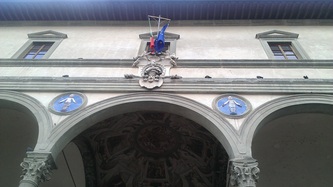

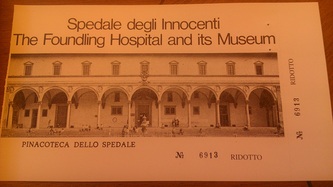


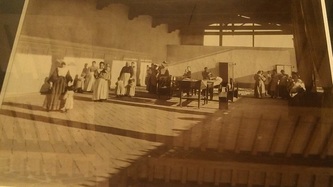

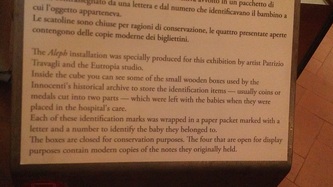


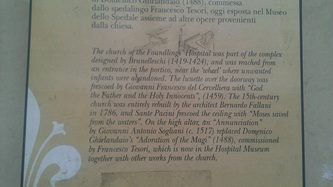
 RSS Feed
RSS Feed